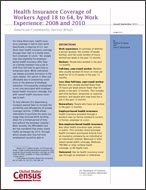
An official website of the United States government
Here’s how you know
Official websites use .gov
A .gov website belongs to an official government organization in the United States.
Secure .gov websites use HTTPS
A lock (
) or https:// means you’ve safely connected to the .gov website. Share sensitive information only on official, secure websites.
-
//
- Census.gov /
- Library /
- Publications /
- Health Insurance Coverage of Workers, by Work Experience: 2008 & 2010
Health Insurance Coverage of Workers Aged 18 to 64, by Work Experience: 2008 and 2010
Health Insurance Coverage of Workers Aged 18 to 64, by Work Experience: 2008 and 2010
Matthew W. Brault and Laura F. Blumenthal
Introduction
For many Americans, health insurance coverage is tied to their work. Specifically, a majority of U.S. residents have health insurance coverage through their own or a family member’s employer or union.1 Yet, people may lose eligibility for employer-based health insurance after they (or a family member) lose a job or shift from full-time to part-time or temporary work. While individuals can always purchase insurance in the open market, this option is often not affordable due to preexisting conditions or the absence of employer subsidies. Consequently, employment is not only associated with employer-based health insurance coverage, but with overall health insurance coverage as well.
To help alleviate this dependency, Congress passed laws to increase the portability and affordability of private coverage options. COBRA allows individuals to purchase the same coverage they received while working, albeit for a limited period of time and without the employer subsidy.2 More recently, the Affordable Care Act has mandated that states create health exchanges by 2014, through which people who lose full-time employment would be able to individually purchase an affordable health insurance plan.3
Using data from the 2008 and 2010 American Community Surveys (ACS), this report explores work experience and health insurance coverage statuses of people aged 18 to 64 in the United States during the years surrounding the trough of the recent recession.4 The data presented are for the civilian noninstitutionalized population. This universe excludes people living in prisons and nursing facilities and those in the armed forces.
__________
1 About 167.1 million people, or 54.9 percent of the civilian noninstitutionalized population, had employer-based health insurance coverage in 2010 (Table B27004, available at <factfinder.census.gov>).
2 Consolidated Omnibus Budget Reconciliation Act of 1985, P.L. 99–272, 100 Stat. 82.
3 Department of Health and Human Services: Initial Guidance to States on Exchanges <www.hhs.gov/ociio/regulations/guidance_to_states_on_exchanges.html>.
4 Because the ACS collects information throughout the year, questions with 12-month retrospectives, like earnings and work experience, yield 1-year ACS estimates with time spans of 23 months. For example, respondents surveyed in January 2008 report their work experience for January 2007 through December 2007, while respondents surveyed in December 2008 report their work experience for December 2007 to November 2008. The comparisons made between 2008 and 2010 ACS estimates do not have overlapping reference periods. For more information, see Hogan, Howard, “Measuring Population Change Using the American Community Survey,” Applied Demography in the 21st Century, eds., Steven H. Murdock and David A. Swanson, Springer Netherlands, 2008.
Others in Series
Publication
Publication
Publication
Share
Related Information
Some content on this site is available in several different electronic formats. Some of the files may require a plug-in or additional software to view.
 Yes
Yes
 No
NoComments or suggestions?


Top

